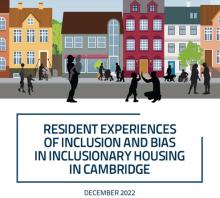March 1, 2023
By Alex Curley and Judith Gonyea
Is it possible to expand affordable housing in U.S. cities and have truly vibrant, diverse, and inclusive communities? During a recent collaboration with the City of Cambridge, Massachusetts, members of the National Initiative on Mixed-Income Communities (NIMC) team had the opportunity to test our beliefs and assumptions about some of the most promising efforts to answer this question.
U.S. cities and towns are increasingly pursuing Inclusionary Housing Programs (IHPs) that require market-rate rental or condominium properties to designate a portion of units as permanently affordable to middle- or low-income households.
Today there are over 1,000 IHPs across the U.S., as more and more cities and towns adopt a forward-thinking approach to maintaining affordable housing in gentrifying neighborhoods or expanding into areas where past discriminatory housing policies and practices such as "NIMBY-ism" (i.e., "Not in my backyard") have prevented affordable housing development.
As an early IHP adopter, Cambridge is home to one of the nation's largest programs, with over 1,200 affordable rental and homeowner IHP units. Our collaboration involved a two-year research project exploring residents' perceptions of their community's social climate.
Because of the City's commitment to promoting diversity and inclusion, Cambridge prioritized input from community members about how economic and/or social divisions might be affecting their daily lives and interactions based on their type of housing—living in an affordable IHP unit or market-rate unit in a mixed-income building, as well as an affordable household in an income-restricted development. For the City, gaining this feedback would be timely as it is actively expanding IHP in new housing developments.
Working collaboratively with the City, NIMC developed a comprehensive telephone survey to answer three main questions; (1) How do residents experience their community to be welcoming and inclusive? (2) To what extent do residents experience bias, stigma, and exclusion? and (3) How do residents' experiences differ based on their various social identities, including their gender, race, ethnicity, and age, as well as being a household with children and/or living in an IHP-designated unit.
To answer these questions, NIMC conducted a phone survey (offered in four languages) with 430 Cambridge residents, including 300 of whom were living in affordable IHP units as well as 130 from two comparison groups: residents living in market-rate units in the same buildings and residents living in "all-affordable" (or income restricted) buildings. Through continuous outreach, we connected with a very racially and ethnically diverse group of residents; for example, respondents represented 20 different primary language groups.
The survey revealed that the majority of interviewed Cambridge residents across all three housing groups feel connected to the City and like living in their neighborhoods. Additionally, although renters of affordable IHP units feel less connected to other residents and feel they have less influence in the building than their owner counterparts, the vast majority of both groups feel "at home" in their building or complex.
Yet, while the majority of residents of affordable IHP units were appreciative of their housing and IHP program, and many had positive experiences, a sizeable group, 40%, reported experiencing bias in their buildings or housing complexes in the past year (as measured using a modified version of Williams (1997) Everyday Discrimination Scale). The experienced biases included people acting as if they are "better than you" or as if "you are not smart," as well as being treated with "less respect" and "less courtesy."
Residents often attributed the bias to their race, low income, living in an affordable unit, having children, and gender. Property management staff and market-rate residents in their buildings were the primary sources of bias—or the people showing bias against residents. Very few residents in affordable IHP units felt their fellow IHP residents were a source of bias.
Residents of affordable IHP units experienced significantly greater frequency exposure to bias than residents in market-rate units in the same buildings. Overall, our findings are consistent with what we have learned from decades of implementation and research on mixed-income communities: mixing units alone does not lead to inclusive mixed communities without intentional strategies and operating practices that support community building and promote racial equity and inclusion.
These study findings and recommendations were shared with residents through three community meetings (online and in person) and presented to the Cambridge City Council Housing Committee. In addition to the Cambridge City Council and City staff, Cambridge Mayor Siddiqui was deeply engaged with the findings and recommendations. She committed to using this research to strengthen the Inclusionary Housing Program to create more welcoming and inclusive communities. Read the full report to the City of Cambridge.


